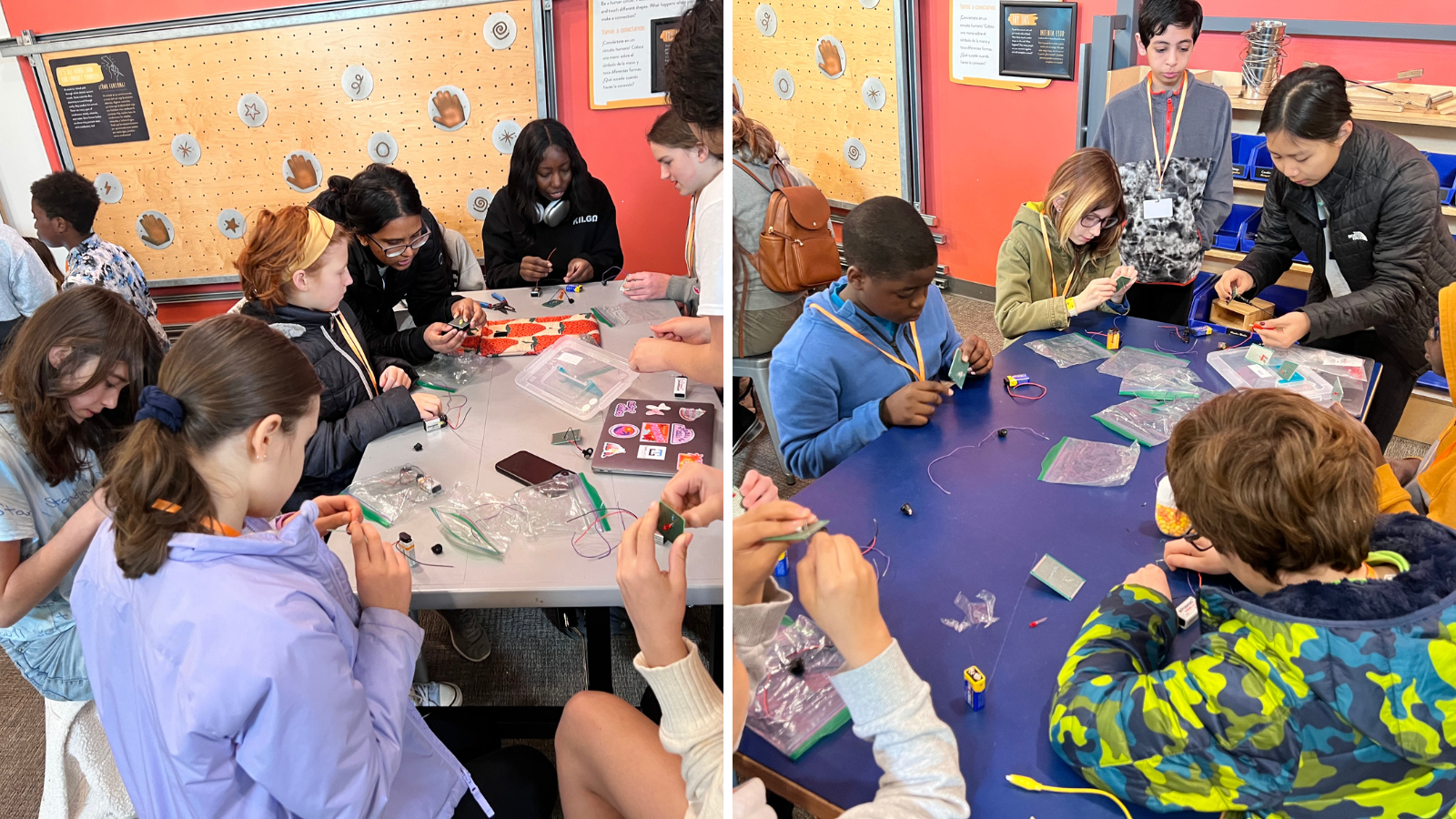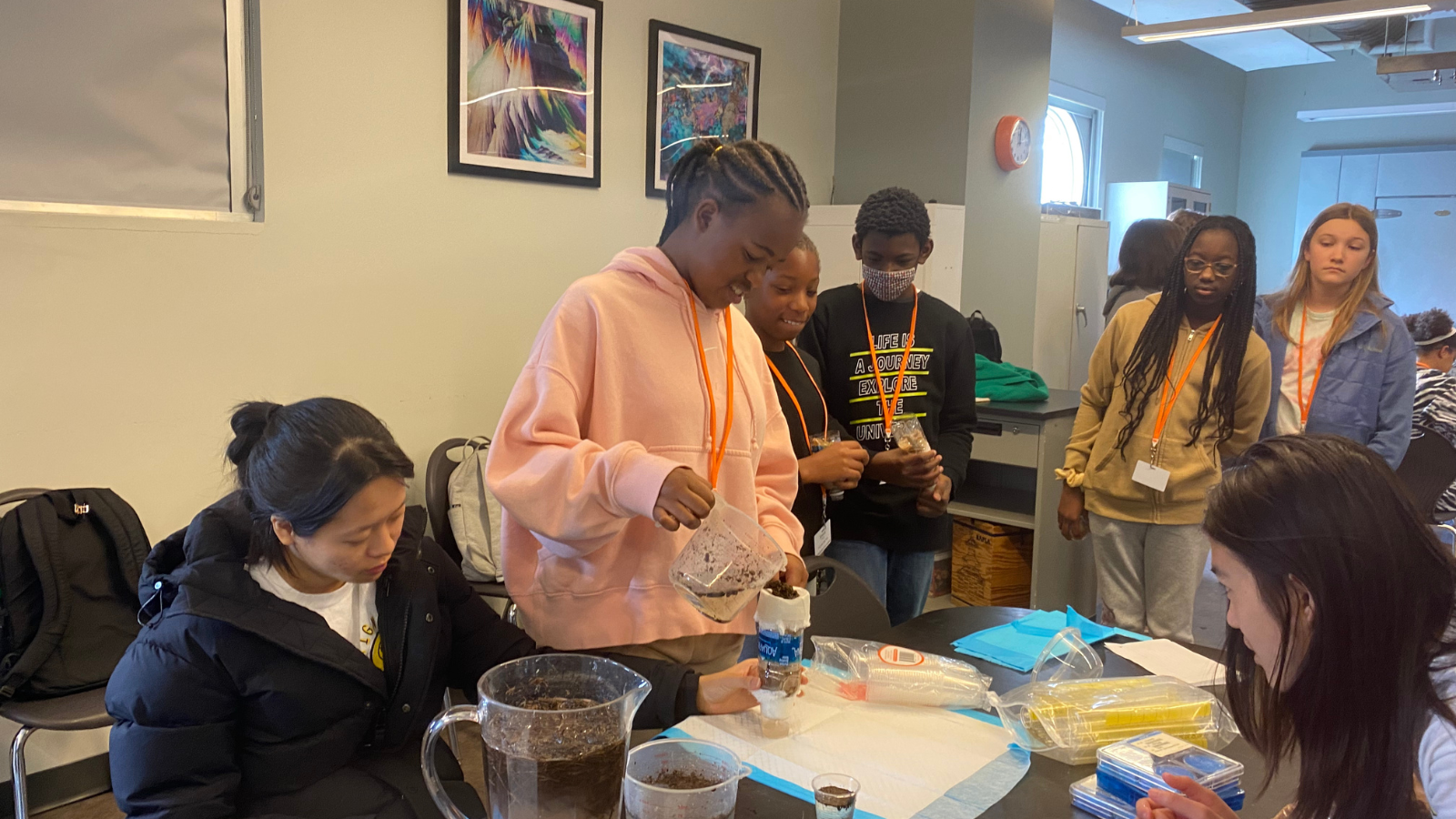Museum Partnerships Serve as Roots for Growing Kids’ STEM Identity
March 21, 2024
Two Bass Connections teams are studying the relationship between informal learning and STEM identity formation in partnership with the Museum of Life and Science in Durham.

By: Antonia Terrazas and Meghan O'Neil
Young children have often been characterized as little scientists – they encounter their environment with curiosity and a drive to experiment with the objects in the world around them. However, when the same kids encounter science and related STEM fields in school, many of them struggle.
With many kids shying away from STEM and a critical shortage in the STEM workforce in the United States, scientists, educators and policy makers have wondered: What kinds of activities and environments – educational or otherwise – can help keep kids’ curiosity alive and help them build a positive STEM “identity”?
Recent research suggests the answer may not be based exclusively in the classroom: For example, curiosity-driven exploration, hands-on experimentation and real-world application of learning outside a traditional classroom setting have emerged as an important tool for building positive STEM identities in young people. Informal education opportunities, ranging from tinkering with gadgets to exploring digital platforms to participating in community-based projects, offer a dynamic pathway for youth of all ages to acquire new knowledge, cultivate a connection with STEM disciplines and explore career pathways outside of a classroom setting.

This year, two Bass Connections teams are studying the relationship between informal learning and STEM identity formation in partnership with the Museum of Life and Science, Durham’s hub for innovative community science education. Both teams are driven by a commitment to improving access to unique forms of STEM education (especially for racial and gender minorities), but each team’s approach leverages unique elements of the museum’s strengths in science education, community programming and outreach. These are their stories.
Expanding the Concept of Science Through the “Living Lab” of a Museum
Led by Tamar Kushnir (Psychology & Neuroscience) and Sarah Gaither (Psychology & Neuroscience), the Increasing Children’s Sense of Belonging in STEM Fields team is working to broaden young children’s views of what science is and who can be a scientist.
“Even when kids are very little, their feelings of inclusivity, identity and belonging are formed,” said Kushnir. “These are feelings of, ‘This is something that’s for me, this is something that people like me do and this is something that I can do.’” All these thoughts and associations contribute to the sense of being empowered to do science, “even before kids are doing any science at all in school,” she said.
The project originated from Kushnir’s long-standing interest in how informal learning environments like museums can foster STEM motivation in young children. As a self-proclaimed “museum kid” growing up, she saw firsthand how these experiences planted the seeds for her own science career.
Teaming up with Sarah Gaither, an expert in social identity formation, the duo set out to examine children’s perceptions of science identity in partnership with Peregrine Bratschi, a science educator and the associate program manager of The Lab at the Museum of Life and Science.
“The Museum of Life and Science is very different from a lot of others I’ve been to in the U.S.,” Gaither explained. “It has a butterfly house, a barnyard and a choo-choo train that runs through it. So, there are lots of things that kids can do there that help you think about science differently. And that’s really what caused us to think about this museum space as being a unique opportunity for kids.”

The Bass Connections team’s goal was to boost STEM identity and belongingness among racial and ethnic minority children from groups traditionally underrepresented in science. Guest speakers and robust discussions guided their research toward broadening and diversifying the concept of “science” in and of itself. The team is exploring ways to bring science identity closer to home – to show children that they are already engaged in scientific exploration through everyday activities, and that science can encompass a wide variety of settings, methods and points of view.
For students on the team who were newer to research, the ability to shape the project’s overarching goals and consider how to look at science differently has been empowering. “It was really cool to see what [questions] excited the undergraduate students on our team and we kind of just ran behind them and tried to support them as best as we could,” said doctoral student Mercedes Muñoz.
To examine how children at the museum perceive and identify with science, students on the team lead workshops using a set of interactive storybook tools. The first storybook depicts stereotypical science exhibits, such as those with chemistry sets and lab equipment, while the other depicts alternative museum spaces and objects, such as the farm, the butterfly room and musical instruments. Children are randomly assigned one storybook or the other, and team members lead the children through a discussion of each picture in their book and then ask them a series of questions to assess their perception of what constitutes “science” and a “scientist.”

According to Kushnir, “What the team has found so far is that even though the kids are having a fun, engaging experience either way and report similar rates of liking science in both cases, they are statistically more likely to feel a sense of closeness to the “scientist” identity in the counter-stereotypical condition. This suggests that broadening beyond the typical depictions of science might foster a sense of inclusivity and belonging, even in children as young as 4-9 years old.”
For this team, the research experience has mirrored the goals of the study itself, with team members crediting the experience with increasing their own sense of community and belonging. "Through this Bass Connections team, I have fostered a greater sense of belonging in the Duke research scene,” said senior undergraduate Janvi Kavathia. “I have really enjoyed working in the local Durham community, connecting families with Duke and seeing children engage with our team to work together on the science tasks.”
Second-year undergraduate Maria Brown agreed, stating, “My favorite part of working with Bass Connections has been watching children become excited about the living lab. A lot of our activities were repurposed from the museum which has really helped strengthen our partnership.”

For Kushnir, the experience of leading a Bass Connections team has surpassed her expectations. “The things that are happening now in the project are beyond my wildest dreams. We keep learning from each other and from the students. I mean, they’re fearless, they’ve taken it on. They’re supportive of each other. Nobody’s pulling weight more than anyone else. Everybody’s very collaborative. Everybody’s invested. I just think that it’s rare to have a group like this. I've worked on a lot of teams. They don't all work like that!”
Looking ahead, team members hope to publish their findings and apply for additional funding that could scale this approach to broadening participation in STEM to other informal learning programs nationwide.
Tinkering Toward Self-Efficacy and Community Identity
While Kushnir and Gaither’s team used Bass Connections as an incubation space to get their project off the ground, the leaders of Ignite: Improving Students’ STEM-Identity Through Human-Centered Design have built a team to evaluate and improve on a long-running STEM educational program.
Now in its fourth year, Ignite is an engineering education program designed to promote creativity and community problem-solving in middle- and high-school students and empower them as future innovators. Led by Duke biomedical engineering faculty Megan Madonna and Nimmi Ramanujam, the program connects youth with Duke undergraduate student mentors to identify a real-world problem, then brainstorm, prototype and test their solutions using human-centered design principles.

In 2021, Ignite began partnering with David Knudsen, an associate program manager on the Museum of Life and Science’s Education and Engagement team, to implement the curriculum with local middle- and high-school students with a focus on North Carolina-specific engineering challenges. Since then, the program has continued to grow, and evaluations have shown that those who participate in Ignite have more confidence in their ability to do well in STEM, and also have better knowledge and positive attitudes towards these subjects.
While the program has been successful, Madonna, Ramanujam and Knudsen still wondered how to make the program better – what elements could be strengthened that would make the experience of this program resonate for its participants and empower their STEM identity?
“If you ask someone what got them interested in STEM … it is often an informal education experience,” said Madonna. “They went to this camp, or they did that program or this visit. And we want to know, what part of those experiences makes them stick? Can you distill down the most impactful parts of the program that track with retention long term? Can we figure out what the secret ingredients are?”

It’s this quest for those “secret ingredients” that drives the Bass Connections team. In the fall semester, team members were introduced to the Ignite program and learned about education research methods. Then, they worked to develop a way to study and improve Ignite, including developing a data management plan and constructing metrics for measuring student engagement and retention.
"We were really impressed by how much the students were able to accomplish in the fall to set us up for success in the spring," Madonna shared. “They were the ones governing the overall research question.”
This spring, students established a research framework that focused on not just strengthening engineering identity but also how the program impacts students’ community identities. By solving real-world problems tied to local, North Carolina-specific goals, team members hypothesized the program could increase how participants see themselves helping their communities. This hypothesis, spearheaded by the undergraduate team members, was novel and brought a new dimension to Ignite’s goals.
As researchers, team members observe Ignite’s middle school sessions, tracking engagement and participation to see what energizes participants. Ultimately, their findings will help address whether the engineering design curriculum can boost both engineering and community identities among participants.

Madonna credits the Bass Connections project team with providing a space to intentionally improve Ignite through an educational research lens. Both the program and the museum have benefited from the cross-pollination of perspectives and expertise, with Knudsen offering best practices for instructing different age groups and the Bass Connections team’s findings supporting the museum’s goals of community engagement and program evaluation.
“We want to know how best to build a program that supports and elevates participants’ community identity while also increasing their STEM identity and engagement,” Knudsen said.
The Ignite team will continue their work next year, with the goal of building on their findings to continue improving the program.
The Impact of Museum Partnerships
The partnership between the Museum of Life and Science and these Bass Connections teams has exemplified the potential of community-engaged research. Working together with the museum’s education staff, these teams are creating inclusive, accessible and effective STEM education for young people in Durham. At the same time, student team members have also developed a deeper understanding of science and the bidirectional impacts of community-engaged research.
“I was really excited to do research with a community partner,” noted Dena Silver, a senior studying Biology, and her experience has lived up to her expectations. “Oftentimes research can feel really technical and exclusive, so this experience has been great because we have focused our ideas around our museum partnership.”
By centering community needs, team members have pushed on the boundaries of how “science” can be engaged and understood. At the same time, they’ve experienced a more exciting, impact-driven form of what “research” can really be.
Learn More
- Learn more about these teams and others at the 2024 Fortin Foundation Bass Connections Showcase on April 17 from 3:30-6 p.m. in Penn Pavilion.
- Read additional profiles of Bass Connections teams.
- See what students and alumni are saying about their Bass Connections experiences.
